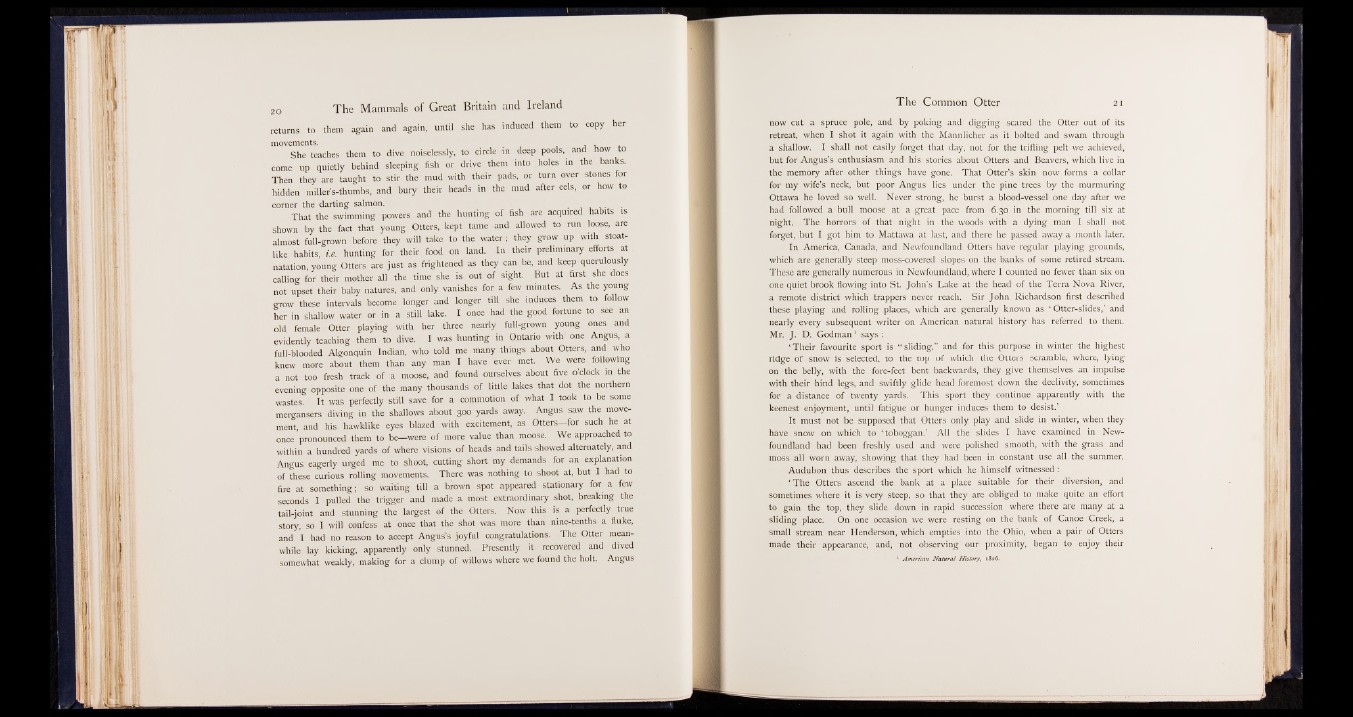
returns to them again and again, until she has induced them to copy her
movements. ,
She them to dive noiselessly, to circle in deep pools, and how to
come up quietly behind sleeping fish or drive them into holes in the banks.
Then they are taught to stir the mud with their pads, or turn over stones for
hidden miller's-thumbs, and bury their heads in the mud after eels, or how to
corner the darting salmon.
That the swimming powers and the hunting of fish are acquired habits is
shown by the fact that young Otters, kept tame and allowed to run loose, are
almost full-grown before they will take to the water; they grow up with stoatlike
habits, i.e. hunting for their food on land. In their preliminary efforts at
natation, young Otters are just as frightened as they can be, and keep querulously
calling for their mother all the time she is out of sight. But at first she does
not upset their baby natures, and only vanishes for a few minutes. As the young
grow these intervals become longer and longer till she induces them to follow
her in shallow water or in a still lake. I once had the good fortune to see an
old female Otter playing with her three nearly full-grown young ones and
evidently teaching them to dive. I was hunting in Ontario with' one Angus, a
full-blooded Algonquin Indian, who told me many things about Otters, and who
knew more about them than any man I have ever met. We were following
a not too fresh track of a moose, and found ourselves about five o’clock in the
evening opposite one of the many thousands of little lakes that dot the northern
wastes. It was perfectly still save for a commotion of what I took to be some
mergansers diving in the shallows about 300 yards away. Angus saw the movement,
and his hawklike eyes blazed with excitement, as Otters—for such he at
once pronounced them to be—were of more value than moose. We approached to
within a hundred yards of where visions of heads and tails showed alternately, and
Angus eagerly urged me to shoot, cutting short my demands for an explanation
of these curious rolling movements. There was nothing to shoot at, but I had to
fire at something; so waiting till a brown spot appeared stationary for a few
seconds I pulled the trigger and made a most extraordinary shot, breaking the
tail-joint and stunning the largest of the Otters. Now this is a perfectly true
story, so I will confess at once that the shot was more than nine-tenths a fluke,
and I had no reason to accept Angus’s joyful congratulations. The Otter meanwhile
lay kicking, apparently only stunned.. Presently it recovered and dived
somewhat weakly, making for a clump of willows where we found the holt. Angus
now cut a spruce pole, and by poking and digging scared the Otter out of its
retreat, when I shot it again with the Mannlicher as it bolted and swam through
a shallow. I shall not easily forget that day, not for the trifling pelt we achieved,
but for Angus’s enthusiasm and his stories about Otters and Beavers, which live in
the memory after other things have gone. That Otter’s skin now forms a collar
for my wife’s neck, but poor Angus lies under the pine trees by the murmuring
Ottawa he loved so well. Never strong, he burst a blood-vessel one day after we
had followed a bull moose at a great pace from 6.30 in the morning till six at
night. The horrors of that night in the woods with a dying man I shall not
forget, but I got him to Mattawa at last, and there he passed away a month later.
In America, Canada, and Newfoundland Otters have regular playing grounds,
which are generally steep moss-covered slopes on the banks of some retired stream.
These are generally numerous in Newfoundland, where I counted no fewer than six on
one quiet brook flowing into St. John’s Lake at the head of the Terra Nova River,
a remote district which trappers never reach. S ir John Richardson first described
these playing and rolling places, which are generally known as ‘ Otter-slides,’ and
nearly every subsequent writer on American natural history has referred to them.
Mr. J . D. Godman1 says :
‘ Their favourite sport is “ sliding,” and for this purpose in winter the highest
ridge of snow is selected, to the top of which the Otters scramble, where, lying
on the belly, with the fore-feet bent backwards, they give themselves an impulse
with their hind legs, and swiftly glide head foremost down the declivity, sometimes
for a distance of twenty yards. This sport they continue apparently with the
keenest enjoyment, until fatigue or hunger induces them to desist.’
It must not be supposed that Otters only play and slide in winter, when they
have snow on which to ‘ toboggan.’ All the slides I have examined in Newfoundland
had been freshly used and were polished smooth, with the grass and
moss all worn away, showing that they had been in constant use all the summer.
Audubon thus describes the sport which he himself witnessed:
‘ The Otters ascend the bank at a place suitable for their diversion, and
sometimes where it is very steep, so that they are obliged to make quite an effort
to gain the top, they slide down in rapid succession where there are many at a
sliding place. On one occasion we were resting on the bank of Canoe Creek, a
small stream near Henderson, which empties into the Ohio, when a pair of Otters
made their appearance, and, not observing our proximity, began to enjoy their
1 American Natural History, 1826.